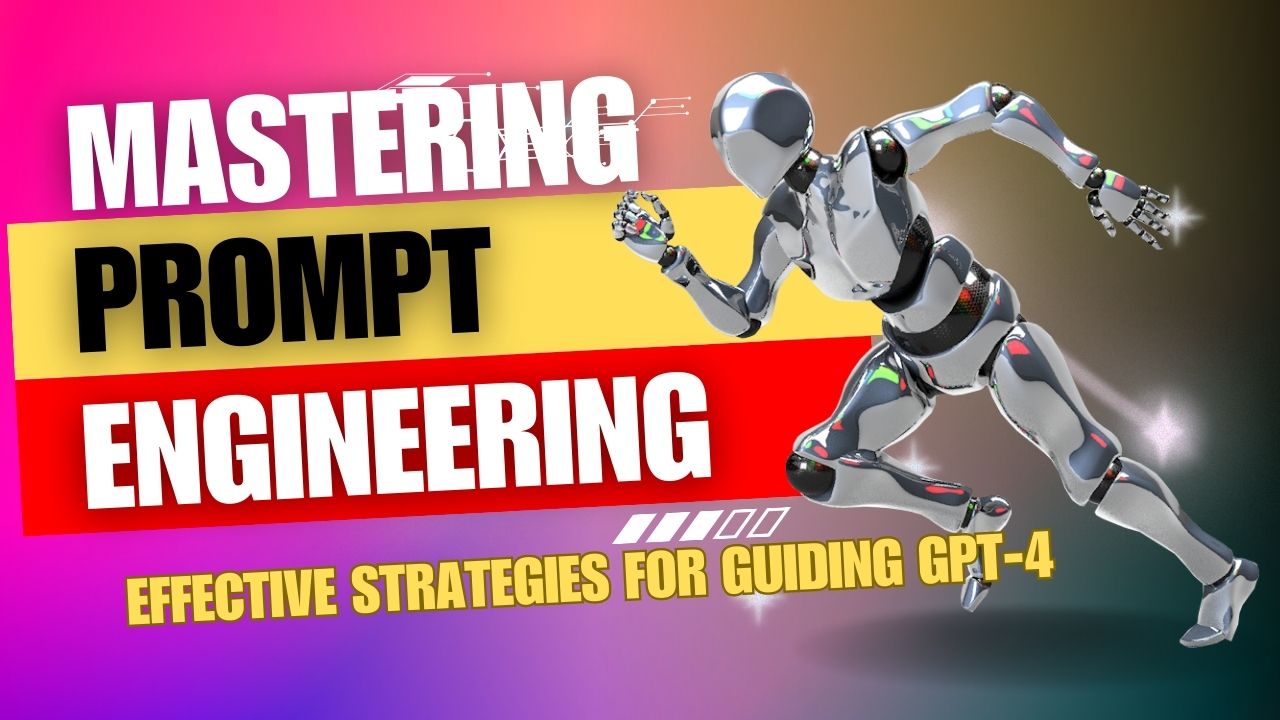**Introduction:**
Prompt engineering is the key to generating accurate and meaningful results from models like GPT-4 in the field of artificial intelligence. Consider conversing with an AI that recognizes your wants, reacts properly, and even matches specific writing styles. This blog post will enter into the field of prompt engineering, walking you through ways for optimizing your interactions with GPT-4.
**Crafting Effective Prompts for AI Success:**
Prompt engineering, at its core, entails producing well-crafted prompts to direct the AI model's output. It's similar to giving a set of instructions to a skilled assistant and ensuring the results match your specifications. This technique is critical for producing high-quality, relevant results while saving time and costs. Anyone dealing with AI models should be able to perform effective rapid engineering.
**Decoding the Process: Drafting and Refining Prompts:**
When dealing with GPT-4, it is critical to begin with a clear and explicit prompt. Begin by defining the task, stating the intended output format, and providing contextual information. Refinement occurs when feedback from GPT-4's early responses assists you in fine-tuning your instructions. This repeated procedure ensures that the model's output matches your expectations more closely.
**The Power of Priming Prompts: Setting the Stage:**
The first prompt, also known as the priming prompt, establishes the tone and style of the subsequent discourse. You can mold the AI's responses to reflect specific voices or personas by establishing stylistic preferences, assigning macros, and providing formatting instructions. A well-structured priming prompt serves as a style guide, improving the overall cohesion of the encounter.
**Breaking Down Tasks: Strategies for Effective Task Decomposition:**
GPT-4 and other AI models can be overwhelmed by large tasks. Task decomposition comes in handy here, allowing you to break down large jobs into smaller, more manageable subtasks. Three effective strategies are as follows:
- **Divide and Conquer:** Divide a problem into manageable chunks.
- **Functional Decomposition:** Determine the primary and secondary functions.
- **Input and Output Analysis:** Analyze inputs and outputs to decide which subtasks are required.
**Creating a Task Hierarchy: Optimizing Your Prompting Strategy:**
After breaking down tasks, logically organize subtasks and establish the amount of granularity required for each. Strike a balance between high-level summaries and detailed information. This method allows you to define clear objectives for each subtask and base your prompting strategy on them.
**Conclusion: Navigating GPT-4 with Expert Prompt Engineering:**
Mastering the art of prompt engineering will allow you to interface with AI models like GPT-4 with remarkable precision and relevance. You can use AI to help you in a variety of areas and tasks by creating effective prompts, breaking down tasks, and optimizing your prompting strategy. Adopt these tactics to direct GPT-4 to produce results that are in line with your demands and goals.
**Frequently Asked Questions (FAQ) - Mastering Prompt Engineering with GPT-4**
**Q1: What is prompt engineering, and why is it important?**
Prompt engineering is the process of creating precise prompts to guide the output of AI models such as GPT-4. It's critical because well-crafted prompts ensure that AI-generated outcomes are accurate and of high quality. Prompt engineering improves output accuracy and relevance while saving time and money in post-processing and editing.
**Q2: How can I draft and refine prompts effectively?**
Begin by defining the task in your prompt and choosing the desired output format. Iteratively adjust prompts based on feedback from GPT-4's initial responses. It's critical to strike a balance between precision and inventiveness, and testing and assessing prompts can help you fine-tune them even more for better results.
**Q3: What is a priming prompt, and why is it important?**
A priming prompt is the initial message you send to AI to set the tone and style. It encompasses formatting, style, and even macros for defining distinct personas or voices. A well-structured priming cue guarantees that the AI responds in a unified and consistent manner throughout the dialogue.
**Q4: How can I break down complex tasks for AI interactions?**
Task decomposition is essential for properly managing large projects. Techniques such as "Divide and Conquer," which includes breaking an issue down into smaller sections, "Functional Decomposition," which involves identifying primary and subfunctions, and "Input and Output Analysis," which involves analyzing inputs and outputs to establish subtasks, can be used.
**Q5: How can I create an optimized task hierarchy for prompt engineering?**
After decomposing tasks, logically organize subtasks and assess the level of detail required for each. To define clear objectives for each subtask, strike a balance between high-level summaries and granular specifics. This method assists you in developing a well-structured prompting strategy.
**Q6: What is the role of context in prompt engineering?**
In prompt engineering, context refers to giving background information to guide AI replies. It comprises information about the intended audience, domain, or product. Providing context assists GPT-4 in better understanding the task and producing more tailored and relevant results.
**Q7: What are some benefits of using macro-based prompting?**
Macros are keyboard shortcuts that allow you to apply complicated prompts to a single word or phrase. Using macros simplifies interactions with GPT-4, allowing you to deliver comprehensive instructions without having to repeat lengthy prompts. They improve AI interaction efficiency and consistency.
**Q8: How do I ensure a well-rounded AI-generated response?**
In your prompt, indicate the desired outcome, length of output, format, and style for a thorough response. By clearly describing these factors, GPT-4 is able to create responses that are in line with your expectations and requirements.
**Q9: Can you explain the different types of task decomposition techniques?**
Certainly! There are three primary techniques: "Divide and Conquer," which involves breaking a task down into smaller sections; "Functional Decomposition," which identifies main and subfunctions; and "Input and Output Analysis," which involves analyzing inputs and outputs to discover subtasks. These strategies aid in the efficient management of complex jobs.
**Q10: How can I balance specificity and creativity in my prompts?**
While specificity is essential for precise output, you may also stimulate creativity by avoiding overly restrictive instructions. Include keywords that encourage creative and distinctive responses while offering clear parameters to ensure appropriate results.
**Q11: Is task decomposition necessary for every AI interaction?**
Task decomposition is especially beneficial for large projects that can overload AI models. Simpler tasks may not require substantial decomposition. However, taking into account the level of granularity required can still improve the quality of AI-generated products.
**Q12: Can I use these techniques with other AI models besides GPT-4?**
Yes, prompt engineering, task breakdown, and context setting ideas can be applied to diverse AI models. The specific commands and prompts may differ based on the capabilities of the model, but the basic strategies remain applicable.
**Q13: Are there any resources to help me create effective prompts?**
Absolutely. There is a link in the blog post to a repository that contains a list of formats, styles, voices, verbs, and adjectives that you can use in your prompts. This repository can be used as a source of inspiration to create intriguing prompts for a variety of purposes.
**Q14: Can you summarize the main benefits of effective prompt engineering?**
Certainly! Effective rapid engineering guarantees that AI-generated outputs are correct, relevant, and of high quality. It saves time and costs by reducing the need for post-processing and editing. It improves interactions with AI models, helping you to reach your goals more quickly.
**Q15: How can I get started with prompt engineering and GPT-4?**
Begin by analyzing the needs of your project and breaking down complex jobs into manageable subtasks. Create clear and detailed prompts using the approaches outlined in the blog post. To tailor AI interactions, experiment with priming cues and context setting. You'll get more competent at understanding prompt engineering with GPT-4 as you gain expertise.
#PromptEngineering101 #GPT4Guidance #AIInteractions #EffectivePrompting #TaskDecomposition #PrimingPrompts #CraftingPrompts #OptimizeGPT4 #AIProductivity #ContextGuidance #MacroPrompts #AIEnhancement #TaskHierarchy #PrecisionInPrompts #AIInsights #GPT4Strategies #AICommunication #BreakDownTasks #CustomizedResponses #PromptingTechniques #AIProductivityHacks #OptimalResults #promptengineeringcourse
Written by: Md Muktar Hossain
























